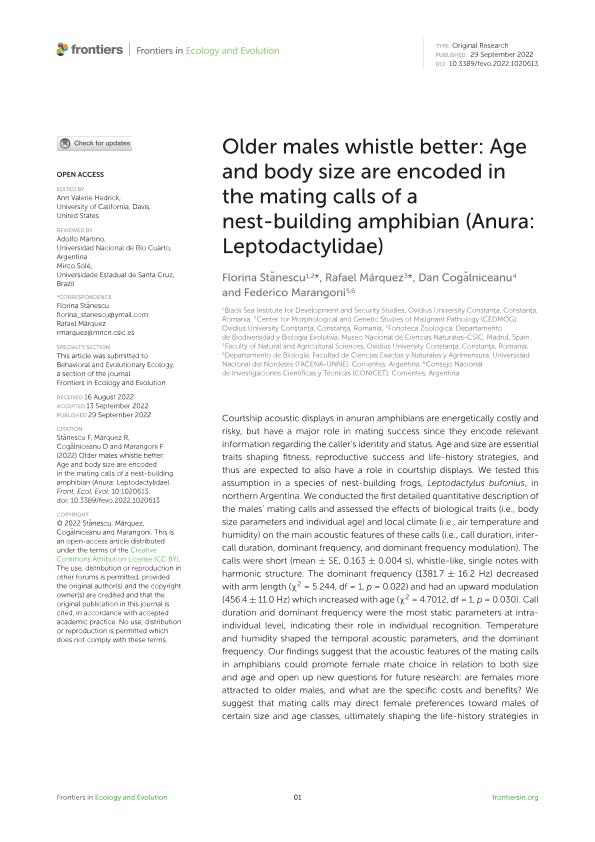Mostrar el registro sencillo del ítem
dc.contributor.author
Stanescu, F.
dc.contributor.author
Marquez, R.
dc.contributor.author
Cogalniceanu, D.
dc.contributor.author
Marangoni, Federico

dc.date.available
2023-11-14T17:22:41Z
dc.date.issued
2022-09
dc.identifier.citation
Stanescu, F.; Marquez, R.; Cogalniceanu, D.; Marangoni, Federico; Older males whistle better: age and body size are encoded in the mating calls of a nest-building amphibian (Anura: Leptodactylidae); Frontiers Media; Frontiers in Ecology and Evolution; 10; 9-2022; 1-8
dc.identifier.issn
2296-701X
dc.identifier.uri
http://hdl.handle.net/11336/218101
dc.description.abstract
Courtship acoustic displays in anuran amphibians are energetically costly and risky, but have a major role in mating success since they encode relevant information regarding the caller’s identity and status. Age and size are essential traits shaping fitness, reproductive success and life-history strategies, and thus are expected to also have a role in courtship displays. We tested this assumption in a species of nest-building frogs, Leptodactylus bufonius, in northern Argentina. We conducted the first detailed quantitative description of the males’ mating calls and assessed the effects of biological traits (i.e., body size parameters and individual age) and local climate (i.e., air temperature and humidity) on the main acoustic features of these calls (i.e., call duration, inter-call duration, dominant frequency, and dominant frequency modulation). The calls were short (mean ± SE, 0.163 ± 0.004 s), whistle-like, single notes with harmonic structure. The dominant frequency (1381.7 ± 16.2 Hz) decreased with arm length (χ2 = 5.244, df = 1, p = 0.022) and had an upward modulation (456.4 ± 11.0 Hz) which increased with age (χ2 = 4.7012, df = 1, p = 0.030). Call duration and dominant frequency were the most static parameters at intra-individual level, indicating their role in individual recognition. Temperature and humidity shaped the temporal acoustic parameters, and the dominant frequency. Our findings suggest that the acoustic features of the mating calls in amphibians could promote female mate choice in relation to both size and age and open up new questions for future research: are females more attracted to older males, and what are the specific costs and benefits? We suggest that mating calls may direct female preferences toward males of certain size and age classes, ultimately shaping the life-history strategies in a given population. Finally, we found discrepancies in the mating calls of L. bufonius recorded from Corrientes and those previously described from other populations, which suggests that multiple species may have been recorded under the same name.
dc.format
application/pdf
dc.language.iso
eng
dc.publisher
Frontiers Media

dc.rights
info:eu-repo/semantics/openAccess
dc.rights.uri
https://creativecommons.org/licenses/by-nc-sa/2.5/ar/
dc.subject
ACOUSTIC PARAMETERS
dc.subject
LIFE-HISTORY STRATEGIES
dc.subject
NEOTROPICAL
dc.subject
SEXUAL SELECTION
dc.subject
SKELETOCHRONOLOGY
dc.subject.classification
Ecología

dc.subject.classification
Ciencias Biológicas

dc.subject.classification
CIENCIAS NATURALES Y EXACTAS

dc.title
Older males whistle better: age and body size are encoded in the mating calls of a nest-building amphibian (Anura: Leptodactylidae)
dc.type
info:eu-repo/semantics/article
dc.type
info:ar-repo/semantics/artículo
dc.type
info:eu-repo/semantics/publishedVersion
dc.date.updated
2023-11-14T14:30:43Z
dc.journal.volume
10
dc.journal.pagination
1-8
dc.journal.pais
Suiza

dc.description.fil
Fil: Stanescu, F.. Ovidius University; Rumania
dc.description.fil
Fil: Marquez, R.. Consejo Superior de Investigaciones Científicas. Museo Nacional de Ciencias Naturales; España
dc.description.fil
Fil: Cogalniceanu, D.. Ovidius University; Rumania
dc.description.fil
Fil: Marangoni, Federico. Universidad Nacional del Nordeste. Facultad de Ciencias Exactas, Naturales y Agrimensura. Departamento de Biología; Argentina. Consejo Nacional de Investigaciones Científicas y Técnicas. Centro Científico Tecnológico Conicet - Nordeste; Argentina
dc.journal.title
Frontiers in Ecology and Evolution
dc.relation.alternativeid
info:eu-repo/semantics/altIdentifier/url/https://www.frontiersin.org/articles/10.3389/fevo.2022.1020613/full
dc.relation.alternativeid
info:eu-repo/semantics/altIdentifier/doi/http://dx.doi.org/10.3389/fevo.2022.1020613
Archivos asociados
